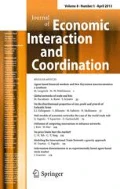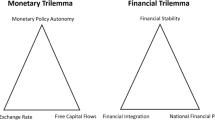Abstract
Following the failure of Lehman Brothers in September 2008, with the liquidity drying up in the interbank lending markets, the scope for short-term arbitrage in forex markets has reduced substantially. Increased counterparty risk and strengthening of prudential norms have resulted in limits of arbitrage. This paper attempts to theoretically examine the impact of limits of arbitrage in a purely deterministic continuous-time model of exchange rates with boundedly rational agents having heterogeneous expectations. The rate of exchange depends on a combination of fundamental factors and speculative behavior by heterogeneous agents in foreign exchange markets. However, given that our focus is primarily on speculators, we keep the determination of the fundamentals outside the scope of our model. We find that under certain situation the limits of arbitrage might increase the stability of the fundamental equilibrium. However, the limits of arbitrage might indirectly destabilize the fundamental equilibrium by causing a reduction in the number of professional arbitrageurs.












Similar content being viewed by others
Notes
However, Ljungqvist and Qian (2016) discussed the possibilities of arbitrageurs circumventing limits of arbitrage by publicly revealing the information that they possess about the fundamentals.
According to Gabaix and Maggiori (2015, p. 1370, Section 1),
“these institutions range from the (former) proprietary desks and investment management arms of global investment banks, such as Goldman Sachs and JP Morgan, to macro and currency hedge funds such as Soros Fund Management to active investment managers and pension funds such as PIMCO and BlackRock.”
See, for instance, de Grauwe and Grimaldi (2006).
The sufficient condition will also be necessary condition, provided \( \bar{w}_2 \ge \min \left[ \dfrac{1}{\beta _s} + \dfrac{\beta _r + \beta _f}{\beta _s \beta _c} , 1 \right] \) .
I am grateful to the referee for pointing this out.
There are two other steady states; however these are complex conjugates containing an imaginary component.
In the context of actual forex markets, for instance, we can think of large financial institutions, forex dealers and market makers in interbank markets as professional arbitrageurs, who would conduct arbitrage as long as not faced with limits of arbitrage. As Gabaix and Maggiori (2015) argued, this section of the market frequently faces financial constraints due to limits of arbitrage of the kind described by Shleifer and Vishny (1997). Rest of the market, however, will not attempt arbitrage because, given the size of forex market, they do not hope to have adequate influence for a successful arbitrage attempt.
There are two other steady states; however these are complex conjugates containing an imaginary component.
We should note here that if we use \(\bar{w}\) as a bifurcation parameter, then changing this parameter will also involve change in the steady state value of w. All the other variables, however, do not depend on \(\bar{w}\).
However, this is true only for the current set of numerical values of parameters, since \(\beta _w\) appears as a coefficient to positive terms in the expression of characteristic roots. This might possibly not hold true for alternative numerical configuration of parameters.
There are two other steady states; however, like (24) these are complex conjugates containing an imaginary component.
References
Akram F, Rime D, Sarno L (2008) Arbitrage in the foreign exchange market: turning on the microscope. J Int Econ 76:237–253
Angelini P, Nobili A, Picillo C (2011) The interbank market after August 2007: what has changed, and why? J Money Credit Bank 43(5):923–958
Baba N, Packer F (2009a) From turmoil to crisis: dislocations in the fx swap market before and after the failure of lehman brothers. J Int Money Finance 28(8):1350–1374
Baba N, Packer F (2009b) Interpreting deviations from covered interest parity during the financial market turmoil of 200708. J Bank Finance 33(11):1953–1962
Bekaert G, Hodrick R (2012) International financial management, 2nd edn. Pearson Education Inc., New Jersey
Brock WA, Hommes CH (1997) A rational route to randomness. Econometrica 65(5):1059–1095
Brock WA, Hommes CH (1998) Heterogeneous beliefs and routes to chaos in a simple asset pricing model. J Econ Dyn Control 22(8):1235–1274
Cecchetti SG, Schoenholtz KL (2017) Money, banking, and financial markets, 5th edn. McGraw-Hill College, New York
Cecchetti SG, Schoenholtz KL (2018) Bank financing: the disappearance of interbank lending. https://www.moneyandbanking.com/commentary/2018/3/4/bank-financing-the-disappearance-of-interbank-lending. Accessed 29 Nov 2018
Chiarella C, He X-Z (2002) Heterogeneous beliefs, risk and learning in a simple asset pricing model. Comput Econ 19(1):95–132
Chiarella C, He X-Z (2003) Heterogeneous beliefs, risk, and learning in a simple asset-pricing model with a market maker. Macroecon Dyn 7(4):503–536
Chiarella C, He X-Z, Zheng M (2013) Heterogeneous expectations and exchange rate dynamics. Eur J Finance 19(5):392–419
Cifarelli G, Paladino G (2018) Can the interaction between a single long-term attractor and heterogeneous trading explain the exchange rate conundrum? Res Int Bus Finance 46:313–323
de Grauwe P, Grimaldi M (2006) The exchange rate in a behavioral finance framework. Princeton University Press, Princeton
Dornbusch R (1976) Expectations and exchange rate dynamics. J Polit Econ 84(6):1161–1176
Du W, Tepper A, Verdelhan A (2018) Deviations from covered interest rate parity. J Finance 73(3):915–957
Fama EF (1970) Efficient capital markets: a review of theory and empirical work. J Finance 25(2):383–417
Flaschel P (2009) The macrodynamics of capitalism: elements for a synthesis of marx, keynes and schumpeter, second revised and enlarged edn. Springer, Berlin
Fong W-M, Valente G, Fung JK (2010) Covered interest arbitrage profits: the role of liquidity and credit risk. J Bank Finance 34(5):1098–1107
Frankel J, Froot K (1986) Understanding the US dollar in the eighties: the expectations of chartists and fundamentalists. Econ Rec (Special Issue):24–38
Gabaix X, Maggiori M (2015) International liquidity and exchange rate dynamics. Q J Econ 130(3):1369–1420
Griffioli TM, Ranaldo A (2010) Limits to arbitrage during the crisis: funding liquidity constraints and covered interest parity. Technical report, Swiss National Bank
Gromb D, Vayanos D (2002) Equilibrium and welfare in markets with financially constrained arbitrageurs. J Financ Econ 66(2):361–407
Gromb D, Vayanos D (2016) Arbitrage and its limits. Palgrave Macmillan, London, pp 1–3
He X-Z, Li K (2012) Heterogeneous beliefs and adaptive behaviour in a continuous-time asset price model. J Econ Dyn Control 36:973–987
Hofbauer J, Sigmund K (1998) Evolutionary games and population dynamics. Cambridge University Press, Cambridge
Hommes CH (2006) Chapter 23: heterogeneous agent models in economics and finance. Handbook of computational economics, vol 2. Elsevier, New York, pp 1109–1186
Kuznetsov YA (1997) Elements of applied bifurcation theory. Applied mathematical sciences, vol 112, 2nd edn. Springer, New York
Kyle AS, Xiong W (2002) Contagion as a wealth effect. J Finance 56(4):1401–1440
Ljungqvist A, Qian W (2016) How constraining are limits to arbitrage? Rev Financ Stud 29(8):1975–2028
Lyons R (2001) The microstructure approach to exchange rates. applied mathematical sciences. MIT Press, Cambridge
Meese R, Rogoff K (1983) Empirical exchange rate models of the seventies: do they fit out of sample? J Int Econ 14(1–2):3–24
Porras Prado M, Saffi PAC, Sturgess J (2016) Ownership structure, limits to arbitrage, and stock returns: evidence from equity lending markets. Rev Financ Stud 29(12):3211–3244
Rime D, Schrimpf A, Syrstad O (2017) Segmented money markets and covered interest parity arbitrage. Technical report, Norges Bank
Sager MJ, Taylor MP (2006) Under the microscope: the structure of the foreign exchange market. Int J Finance Econ 11(1):81–95
Shleifer A, Vishny RW (1997) The limits of arbitrage. J Finance LI I(1):35–55
Westerhoff F (2003) Expectations driven distortions in foreign exchange market. J Econ Behav Organ 51(3):389–412
Westerhoff F, Reitz S (2003) Nonlinearities and cyclical behavior: the role of chartists and fundamentalists. Stud Nonlinear Dyn Econ 7(4):1558–3708. https://www.degruyter.com/view/j/snde.2003.7.4/snde.2003.7.4.1125/snde.2003.7.4.1125.xml?
Author information
Authors and Affiliations
Corresponding author
Additional information
Publisher's Note
Springer Nature remains neutral with regard to jurisdictional claims in published maps and institutional affiliations.
This paper is dedicated to the memory of Prof. Carl Chiarella who passed away in June 2016. Some of preliminary results from this paper were presented at \(22{\mathrm{nd}}\) Annual Workshop on Economic Science with Heterogeneous Interacting Agents in June 2017 and Asia Pacific Economic Conference in November 2017. The author is grateful to the participants of these conferences for their comments. The paper also benefited from the useful suggestions of two referees on the earlier versions of this paper. The usual disclaimer applies.
Rights and permissions
About this article
Cite this article
Datta, S. Exchange rate dynamics under limits of arbitrage and heterogeneous expectations. J Econ Interact Coord 14, 521–550 (2019). https://doi.org/10.1007/s11403-019-00237-6
Received:
Accepted:
Published:
Issue Date:
DOI: https://doi.org/10.1007/s11403-019-00237-6




